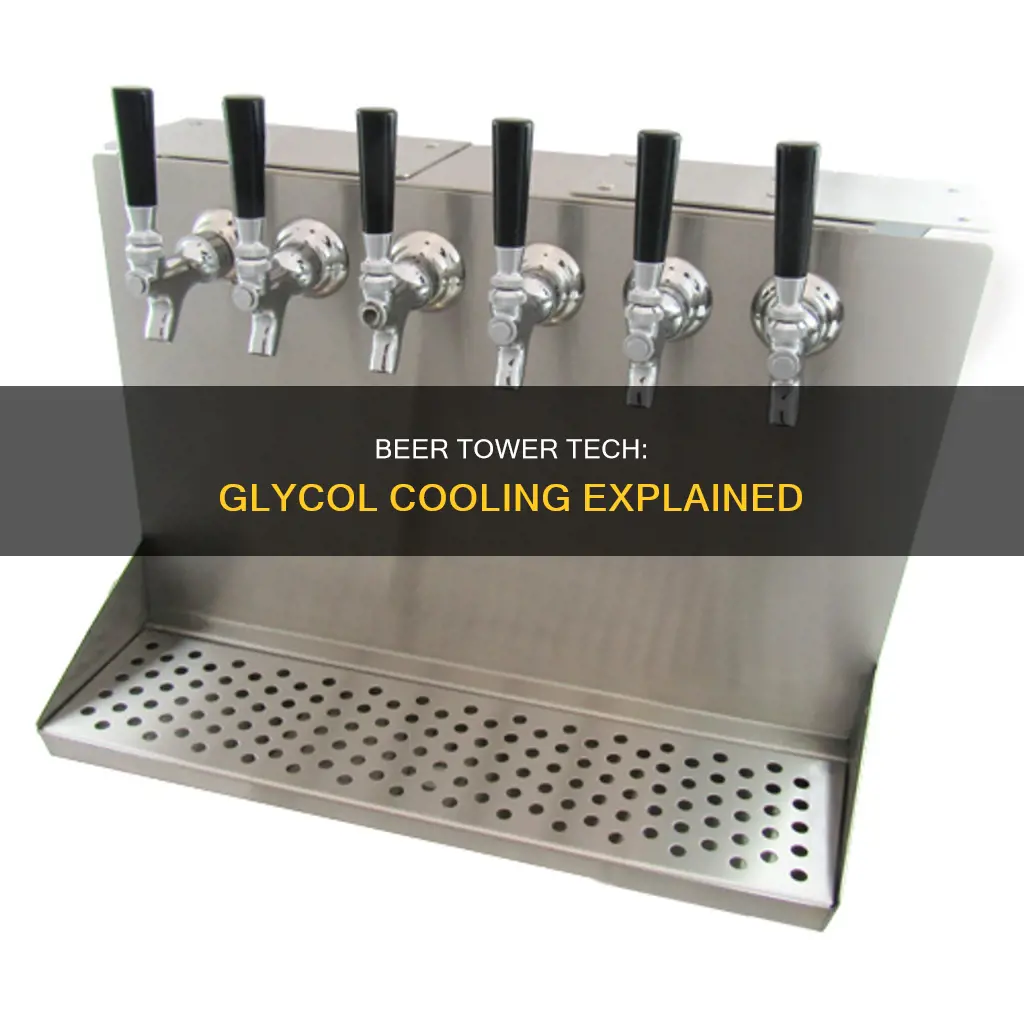
Dispensing cold, fresh-tasting beer is the goal of any bar or restaurant owner, and a glycol-cooled beer tower is an excellent way to achieve this. Glycol-cooled towers are ideal for long-draw systems, maintaining the perfect temperature from keg to glass, even in large establishments with multiple beer styles. This system uses a glycol solution circulated through tubes to keep the beer chilled, allowing for slim, stylish towers. With glycol-cooled towers, there's no need to compromise on space or beer variety, and they are a popular choice for busy bars and restaurants.
What You'll Learn

Glycol-cooled vs air-cooled beer towers
When it comes to glycol-cooled vs air-cooled beer towers, there are several factors to consider, including the setup of your draught beer system, the distance between the beer keg and dispenser, the number of beer styles you plan to serve, and your budget.
Air-Cooled Beer Towers
Air-cooled beer towers are a simple, cost-effective option for small bars and restaurants that offer a limited number of beers and do not require a long-draw beer draught system. These systems use cold air to push the beer from the keg to the faucet, and the keg refrigeration unit should be located right next to the point of service, such as under the counter. The cost of an air-cooled beer tower typically starts around $80, making it an attractive choice for those on a budget.
Glycol-Cooled Beer Towers
Glycol-cooled beer towers, on the other hand, are designed to be used with a beer glycol cooling system, which uses a closed circuit of glycol lines bound to several beer lines to maintain a stable temperature and prevent foam. This type of dispensing setup is known as a "long-draw draught beer system" and is commonly used in large bars, pubs, and restaurants serving multiple beer styles. Glycol-cooled towers are equipped with aluminium cooling blocks attached to each of the faucet shanks inside the tower.
Key Differences
The main difference between glycol-cooled and air-cooled beer towers is the cooling method. Glycol-cooled systems use a chilled water/glycol solution circulated through tubing next to the beer lines, ensuring the beer temperature is maintained completely to the faucet. In contrast, air-cooled systems rely on circulating cold air from the refrigerated storage area inside the tower to keep the beer hoses cold.
Another distinction is the suitability for different types of establishments. Glycol-cooled towers are ideal for large bars or restaurants with a walk-in cooler located more than 25 feet away from the bar area. In contrast, air-cooled towers are better suited for small bars or restaurants that do not have space for a full-size walk-in cooler and offer a limited number of beers.
Beer Subscriptions: How Do They Work?
You may want to see also

How glycol-cooled systems maintain temperature
Glycol-cooled systems maintain temperature through a few key mechanisms. Firstly, glycol is a viscous, colourless, and odourless synthetic liquid with unique thermal properties. It can absorb and release large amounts of heat while maintaining a consistent temperature. This ability to regulate temperature makes it ideal for beverage cooling applications.
The two main types of glycol used in cooling systems are ethylene glycol and propylene glycol. Ethylene glycol is created by combining water with ethylene oxide and is primarily used in industrial applications. Propylene glycol, on the other hand, is a less toxic alternative often used in food, cosmetic, and pharmaceutical products. It is considered food-grade and is commonly used in breweries and food processing.
The specific heat capacity and heat transfer efficiency of glycol play a crucial role in maintaining temperature. In a glycol-cooled system, the glycol is mixed with water and pumped through the pipes of the chilling system. The ratio of glycol to water is critical and depends on the desired temperature and the coldest temperature the solution will reach during operation. A higher concentration of glycol lowers the freezing point, allowing the system to operate at colder temperatures.
Additionally, glycol often contains corrosion inhibitors that help prolong the life of system components. It inhibits bacterial growth and corrosion within the pipes, reducing the likelihood of system failures and costly repairs.
Overall, glycol-cooled systems maintain temperature through the use of glycol's unique thermal properties, careful control of the glycol-water ratio, and the inclusion of corrosion inhibitors. This combination ensures consistent and controlled temperatures, making glycol-cooled systems ideal for various applications, including beverage cooling and industrial refrigeration.
The Ultimate Beer Snorkel Experience: How Does It Work?
You may want to see also

Glycol-cooled systems and long-draw systems
Glycol-cooled systems are ideal for long-draw draught beer systems, where the walk-in cooler is located at least 25 feet away from the point of service. This type of system is perfect for large bars, pubs, and restaurants serving multiple beer styles.
Glycol is a widely used food-grade refrigerant and a key component of a glycol draft beer system. The glycol lines are bound to the beer lines inside a trunk line, which maintains a stable temperature and prevents foaming as the beer flows to the dispenser. The glycol lines never come into contact with the beer. The glycol is pumped through the system, returning to the chiller after passing through the tower.
Glycol-cooled beer towers are designed to be compatible with glycol-cooled draft systems and have space for the trunk line and beer lines. The draft lines run across glycol cooling blocks inside the tower to keep the beer cool. These towers are usually made from ceramic or chrome and can accommodate 1-20 draft lines, depending on the model.
A glycol chiller is a great option for long-draw systems, where the chiller is located at least 75 feet away from the dispensing point. The glycol is combined with water to create a chilled mixture that is pumped through the system, keeping the beer cold from keg to tap. This method ensures the beer is kept at the ideal temperature, maintaining its quality, taste, and texture.
Do Sulfite Wands Really Work for Beer?
You may want to see also

Compatibility of glycol-cooled systems with beer towers
When it comes to dispensing draft beer, maintaining a cold, consistent temperature is critical. Beer must be kept between 36-38°F all the way to the point of dispensing; otherwise, the quality will suffer.
Glycol-cooled systems are ideal for long-draw beer systems, where the walk-in cooler is located far from the point of service (generally 25 feet or more). In these systems, glycol lines are bound to the beer lines in what is known as a trunkline. The beer flows from the keg to the dispenser inside this trunkline, maintaining a stable temperature and preventing foam from forming.
Glycol-cooled beer towers are designed to be compatible with glycol-cooled draft beer systems. These towers have the capacity to hold both the trunk line and the beer lines. The draft lines run across glycol cooling blocks inside the tower to keep the beer cool, and the trunk line returns the glycol to the chiller.
It is important to note that glycol-cooled towers are not interchangeable with air-cooled towers. Air-cooled towers require an open space within the tower to allow for the circulation of cold air, which is not necessary in glycol-cooled systems. Therefore, it is crucial to ensure that the beer tower is glycol-compatible and designed for use with a glycol-cooled dispensing system.
When choosing a glycol-cooled beer tower, factors such as the number of faucets, the material of construction (ceramic or chrome), and the type of tower (single pedestal, double-pedestal, or pass-through) should be considered to ensure compatibility with the specific requirements of the dispensing system.
Beer Slug Traps: Do They Work?
You may want to see also

Parts of a glycol-cooled system
A glycol-cooled system is a popular choice for bars, pubs, tap rooms, and restaurants that need to keep their beer cold and transport it over long distances. Here are the key parts of a glycol-cooled system:
Cooler/Walk-in Cooler:
Firstly, you need a cooler or walk-in cooler that is large enough to store all the kegs. This is where the beer is kept cold, usually at a temperature of 34-38 degrees Fahrenheit.
Insulated Trunk Line/Python:
The trunk line is an essential component of the glycol-cooled system. It is an insulated bundle of lines that the beer travels through from the keg cooler to the faucet in the tower. The trunk line consists of beer lines (product lines) and glycol refrigeration lines (glycol lines) wrapped together. The beer lines are taped to the glycol lines, and the bundle is then wrapped in foil or vapour-wrapped to ensure the beer remains in contact with the cold glycol lines. This maintains a consistent temperature as the beer moves through the lines.
Power Pack/Glycol Chiller:
The power pack, also known as the glycol chiller, is the heart of the glycol-cooled system. It is a refrigeration unit that circulates a mixture of propylene glycol and water through the trunk lines to keep the beer cold. The power pack ensures that the glycol mixture is kept at a specific temperature, usually between 29˚ to 32˚ F. It turns off when the temperature reaches 29˚ F and turns back on at 32˚ F.
Draft Tower/Beer Tower:
The draft tower or beer tower is where the beer is dispensed. It is designed to work with the glycol-cooled system, with the glycol lines set up to come into contact with each beer shank. The tower has stainless steel tubes running through it, welded to the back of the shanks behind the cooling block. The tower is also foam-sealed to prevent condensation and ice build-up.
Tapping Hardware:
Tapping hardware refers to the various parts inside the keg cooler that are necessary for pouring keg beer. This includes the wall brackets that the beer lines attach to, the "jumper" line that runs from the wall bracket to the keg coupler, and the secondary regulators that provide pressure to the keg.
Thermal Beer Mugs: How Do They Keep Drinks Cold?
You may want to see also
Frequently asked questions
A glycol-cooled beer tower is a type of draft beer tower that uses a glycol cooling system to maintain the ideal temperature of the beer as it travels from the keg to the tap. Glycol is a widely used food-grade refrigerant.
In a glycol-cooled beer tower, the glycol lines are bound to the beer lines, forming a closed circuit known as a trunk line. The glycol is pumped through this circuit, maintaining the temperature of the beer inside the tower all the way to the faucet.
Glycol-cooled beer towers are ideal for long-draw draught beer systems, where the walk-in cooler is located far from the point of service (generally 25 feet or more). They are effective at maintaining a consistent temperature, preventing foam, and ensuring the beer is perfectly chilled at the point of pouring.
The choice between an air-cooled and a glycol-cooled beer tower depends on your current draught beer dispensing setup, the distance between the beer keg and the dispenser, the number of different beer styles you plan to dispense, and your specific requirements. Air-cooled towers are typically used for small bars or direct-draw systems with a limited number of beers, while glycol-cooled towers are better suited for large bars, pubs, or restaurants serving multiple beer styles.







